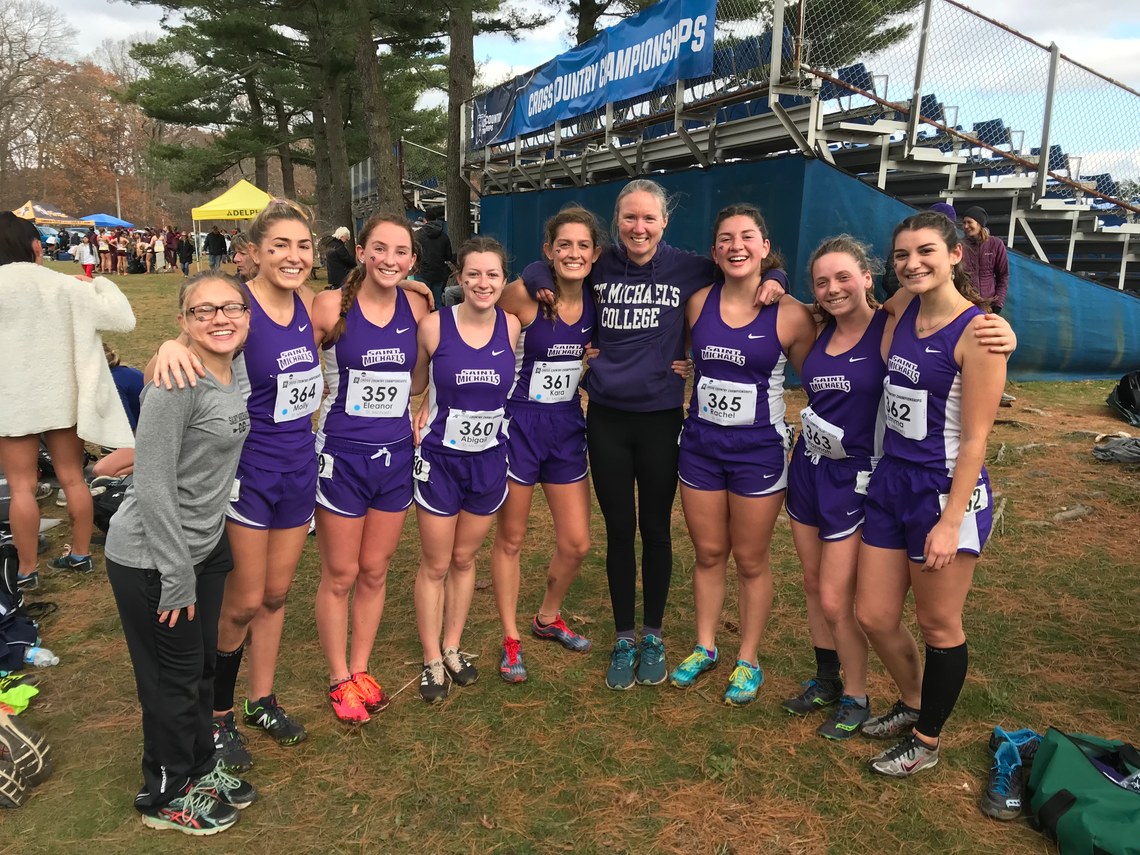
Pictured: Molly Peters (4th in from right) with her Saint Michael's College Women's Cross Country team
Equality in sports has come a long way but there is certainly a lot of road left in the race. It took nearly 90 years for the International Olympic Committee to allow women to race the marathon distance in the Summer Games since the first international Olympic Games in 1896. It wasn't until 1972 that the Amateur Athletic Union (AAU) officially counted women's race results for the marathon distance. Following the AAU's rule change, women's racing exploded. By 1980, 10% of marathon runners in the United States were female. In 2016, that number increased to a record 44% and while it's amazing to see this change, it's 2021 and women are STILL facing equity challenges in running.
The NCAA has different race distances for men and women in Cross Country. At the NCAA Division I and II Championships, the men race 10K and the women race 6K. In Division III, the men race 8K and the women 6K. During the regular season, men usually race 8K or 5 miles and women race 5K or 6K. Molly Peters, head coach of Women's Cross Country and Nordic Skiing for Saint Michael's College, has been advocating to change these discrepancies for years. In her position, she attends coaches' meetings before the Championship meets and every time she has a chance to send new legislation to the NCAA, she ALWAYS asks for equal distance. She found success in getting the Northeast 10 Conference, which Saint Michael's competes in, to raise their Conference Championship to 6K. It was only 5K up until a few years ago.

"My biggest lesson has been to NEVER GIVE UP. I seem to finally be making headway in the Nordic world and it is mainly because I keep asking. Other coaches have finally joined in and we seem to have the majority for the first time. It is exciting and I am hoping that things will start to change next year. If we can ge the NCAA distances changed for Nordic Championships, it will be a major step in the right direction for Cross Country. They also recently changed the World Cross Country Championships to equal distances, which is another huge step in the right direction and more reason to have equality at the NCAA level!"
Peters's Ski Equal group has been working hard to narrow down the reasons why we need equal distances in sports. Their top three reasons are:
1. Tradition does not make inequality acceptable.
We believe that following an archaic model of women always racing shorter distances supports decades of inequality based on tradition, not facts about women's abilities. Tradition does not justify inequality. Women are fully capable of competing in any distance event from a sprint to marathons to ultra-races. Sport is a powerful tool for promoting gender equality and when you only offer shorter distances for women, you are creating an unnecessary barrier for women. This is discrimination.
2. Equal distance races provide a much more equal race experience.
At every level of nationwide racing, women's races are significantly shorter than men's. This creates an entirely different race experience for women and sends an implied message about what female athletes are and are not capable of doing. We have found that when men and women race equal distances, the difference between male and female winners varies but hovers around 12%. However, in these events the difference between the men's winner and the last few male finishers was consistently greater than 30%, often considerably so. In other words, the difference within the men's field was much greater than the different between male and female competitors. This tells us that men and women do not have substantially different race experiences when competing in equal distances. Separate race distances are a solution to a non-exisistent problem. There is no compelling reason to require women and men to race different distances.
3. What message are we sending young women?
Most importantly, what message are we sending to our athletes when we assign shorter distances? Girls and young women are keenly aware of when they're being treated differently from boys and men. When race distances diverge in their formative teenage years, there is an unmistakable subtext, intended or not, that women are not as capable as men. This message is easily internalized by young women, whether they realize it or not. Self-esteem and self-worth are important in every facet of a woman's life, especially for young athletes. Equality in sport prepares women to expect equality in areas such as job opportunities and compensation. All the more reason for equality!
The group is currently petitioning for the major Nordic racing hosts, such as the International Ski Federation, US Ski and Snowboard, and the NCAA, for equal race distances for women in Nordic skiing. They need a little over 400 signatures to reach their goal. Please considering signing here! Molly plans to send another proposal to the NCAA this Spring in her continued fight for equal distances for Cross Country.
A big thank you to Molly for sharing your story with us! We are with you in this fight and will always be cheering you on!
Keep up with the Saint Micheal's College Women's Cross Country by following them on Instagram and Facebook.
